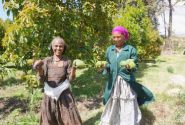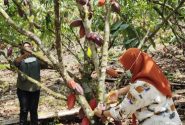
A shortage of biofuel crops threatens India’s 2012 green energy target. Andrew Stawarz
HYDERABAD, India (22 October, 2012)_While India has taken bold steps to move to cleaner fuels, a biting shortage of jatropha fruits used to produce biodiesel means the country will not meet its 2012 target of blending five percent biodiesel into all regular diesel.
An estimated four million hectares of jatropha plantations (and area the size of Switzerland) would need to be grown to supply the biodiesel needed to meet this target, said Navin Sharma, chief scientist with ITC Ltd, Bangalore at Tree Diversity Day at the 11th UN Convention on Biodiversity Conference of Parties in Hyderabad.
He said given current land pressure, cost and sheer logistics, fresh ideas were needed in order to produce crops and trees for bioenergy. India’s fuel consumption is estimated to be close to 150 million tonnes per annum.
Jatropha has been promoted as one of the best arid-land biofuel crops, in part because of the high yields of oil extracted from its seeds. It also has strong resistance to drought and pests.
But cultivating it in a way that is safe for the environment is difficult, says a recent study by the Center for International Forestry Research. Jatropha yields would need to range from 8.6 to 13.9 tonnes of seeds per hectare, per year on arid and semi-arid land for 30 years to repay the carbon debt created by converting forest.
However an agroforestry system in which trees and crops used to make biofuels are grown by millions of smallholder farmers, could help meet the Indian biofuel industry’s demand for raw material and reduce the negative impacts of commercially grown biofuel crops on the environment, said Sharma.
“Even if households planted just a few jatropha trees each, the combined effect could be huge.”
Such a model would have to be paired with the development of early fruiting and drought-tolerant oil-bearing trees, as well as other annual oil-producing crops like castor.
Sharma pointed to recent successes in the Hassan District of Karnataka, India where 1.5 million seedlings of seven locally adapted trees have been grown in thousands of family backyards. Trees are often grown on the periphery of agricultural land to maximise land use.
These diverse agroforestry systems have brought multiple benefits to the farmers of Hassan, he said.
“They are meeting their needs for firewood, timber, fruit and a myriad of other products. Farmers are also selling their jatropha fruit for bioenergy production.”
Even if [Indian] households planted just a few jatropha trees each, the combined effect could be huge.
So successful is the initiative, this year the district is set to become the site of the country’s first bio-fuel distribution station, owned by Bharat Petroleum Corporation Ltd.
Hugo Lamers, a scientist with Bioversity International’s Delhi office, spoke about another case study from the Western Ghats — a biodiversity hotspot also found in Karnataka State.
He described how communities here are now reaping the huge benefits from domesticating and growing unique fruits from the forest. In particular, the cultivation of upage (Garcinia gummi-gutta), a rare type of kokum (white Garcinia Indica) and pickle mango (Mangifera indica) has brought the farmers a consistent source of nutritious fruits, work and income. Lamers said most of the products are developed and produced by women.
Farmers and local communities in the Western Ghats are now working closely with scientists as part of a Biodiversity International pilot project Community Biodiversity Management (CBM) which involves tree improvement, raising seedling nurseries, and processing and marketing tree-derived products.
“This approach consolidates farmers’ and local institutions’ role to make self-directed decisions about the natural resources that are found in their villages,” Lamers said.
“Local communities and the larger world are hungry for products from hundreds of different trees,” said Sharma, adding that the future will be demand-driven, not supply-led.
“Through tree domestication and agroforestry with a diversity of trees, we could meet the huge demand for fruit, nuts, wood, fuel, fodder and medicines, as well as for raw material for biofuel,” he added.
However, Lamers and Sharma were quick to warn that the new biofuel economy boom must benefit smallholders and alleviate poverty in order to be sustainable.
It must “compete globally but be locally inclusive; support large farmers but protect smallholders; step up productivity but conserve nature; and create realistic value chains,” Sharma said.
“And forestry departments should regard smallholders as partners in the protection of forests by allowing sustainable use and fostering ownership over the local resources” concluded Lamers.
We want you to share Forests News content, which is licensed under Creative Commons Attribution-NonCommercial-ShareAlike 4.0 International (CC BY-NC-SA 4.0). This means you are free to redistribute our material for non-commercial purposes. All we ask is that you give Forests News appropriate credit and link to the original Forests News content, indicate if changes were made, and distribute your contributions under the same Creative Commons license. You must notify Forests News if you repost, reprint or reuse our materials by contacting forestsnews@cifor-icraf.org.










